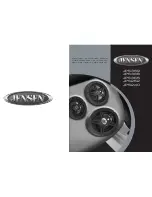
YSM1
P
3
Input Connection
The input, located on the bottom part of the chassis, accepts line-level signal only (not
speaker level). It is recommended to use balanced, shielded cables with ¼ inch (T.R.S.) or
XLR connectors (unbalanced ¼ inch jacks can be used). Each YSMp should be connected
to a single line-level source; e.g., the Right or Left line output from a mixer or preamp. If you
want to use multiple YSMps, they can be interconnected using “Y” adaptors.
Input Trim Control
The Input Trim control allows you to adjust the sensitivity of the input circuit. Control range is
–6 dB to + 9 dB. Adjust accordingly until the desired sound level is achieved (a normal setting
would be 0 dB). If clipping is indicated (see Clip LED), reduce the Input Trim level. If more con-
trol is needed, adjust your line level from the source.
Hi Frequency Reflection Optimization DIP Switches
Walls, ceilings and furnishings reflect high frequencies, this
affects the listening environment. For most room acous-
tics set the lower two DIP switches to the “Normal Room”
[B] configuration (settings are shown on the back-panel.
Otherwise select one of the other two settings to reach the
desired response within the environment.
Low Frequency Efficiency Factor DIP Switches
Due to the long wavelengths of low frequencies, a woof-
er’s acoustic efficiency is affected by its location within the
room, relative to the walls. The diagrams shown on the YSMp
rear control panel depict three typical speaker/room placements referred to as “Full, ½ and ¼
Space.” Set the upper two DIP switches in accordance with the cabinet’s placement; Full Space,
½ Space or ¼ Space (corner placement). /2 Space [E] is considered default.
Power Switch
The power switch is located at the bottom of the rear panel near the AC cord.
Blue Power LED (blue)
When the LED marked PWR is illuminated, the unit is turned on.
Clip LED (red)
The red clip LED, located on the front of the cabinet beside the Blue Power LED, indicates
when the outputs of the internal amplifiers are close to clipping. To maintain ideal perfor-
mance, adjust the YSMp’s Input Trim (or the output level on your mixer or preamplifier) until
the Clip LED stops flickering. Engaging the Clip Limiter (see Limiter Pushbutton) will help
avoid distortion on peaks.
Limiter Pushbutton
The Limiter pushbutton enables the onboard Clip limiter. Set to the IN position, the internal Clip
Limiter is activated. This feature is used to help limit distortion when the amplifier is driven to full
power. The red Clip LED, located on the front of the cabinet, indicates the Limiter’s threshold.
Biamplification
The YSMp uses two amplifiers, one for the tweeter and one for the woofer. The common
term is biamplification, a process which utilizes an electronically active crossover network.
This type of crossover network divides the signal much more precise than traditional pas-
sive crossover networks.
Amplifier Thermal Protection and Limiting
Please ensure that there is adequate space provided around the rear of the speaker cabinet.
Allowing good ventilation to prevent the amplifier from overheating will help prevent the unit
from shutting down.
NOTE: Both of the internal amplifiers are thermally protected, should the back be covered, preventing
adequate heat dissipation (or should some other condition lead to overheating), the amplifiers will shut
down. The amplifiers should reset automatically after a few minutes. This feature should only engage
under severe overheating conditions, proper measures should be taken to permit adequate cooling.
TECH: The woofer and tweeter are protected against sustained overdriving (e.g., feedback) and clipping.
Should the amplifier sense that either condition exists, limiters will begin to reduce the overall output until
more ideal conditions are met. To ensure full-time driver protection (when the Clip limiter is disabled) the
internal limiters will remain on. If the Clip LED becomes active, reduce the Trim Level on the YSM1p, the
preamp, or mixer output level to maintain normal operation.
YSMp configuration options
































